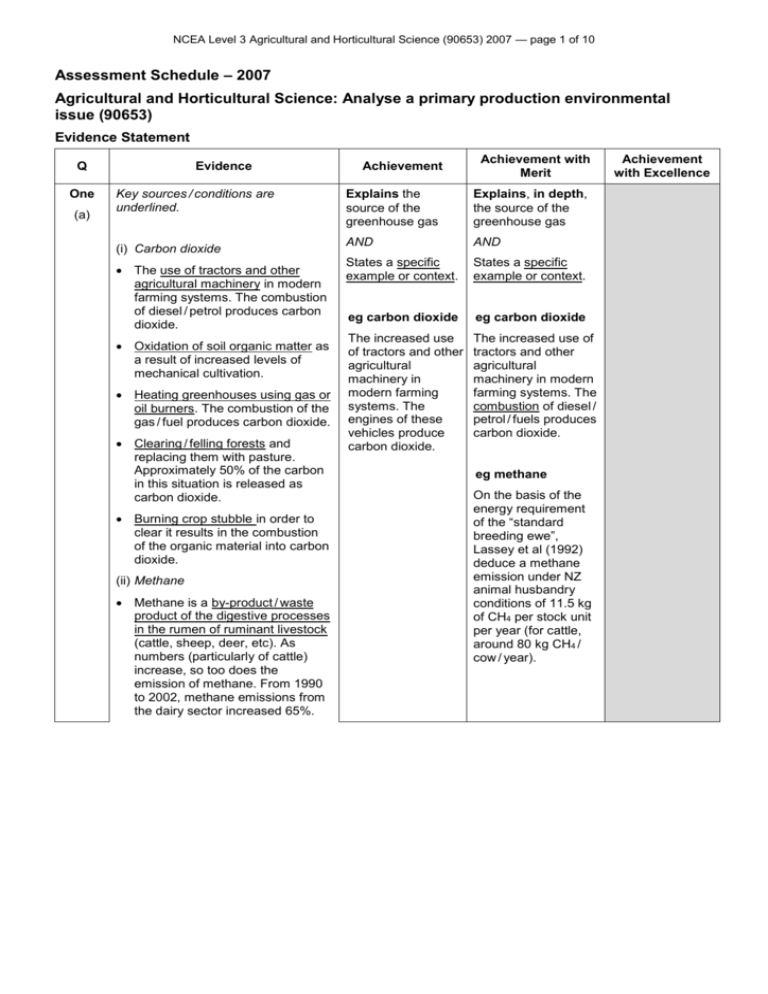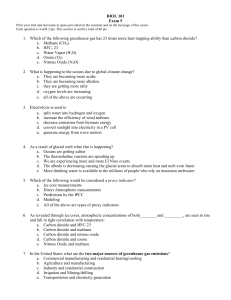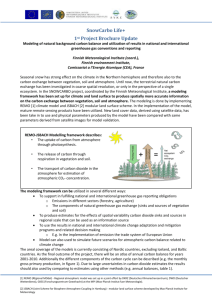2007 Assessment Schedule (90653)
advertisement

NCEA Level 3 Agricultural and Horticultural Science (90653) 2007 — page 1 of 10 Assessment Schedule – 2007 Agricultural and Horticultural Science: Analyse a primary production environmental issue (90653) Evidence Statement Q One (a) Evidence Key sources / conditions are underlined. Achievement Achievement with Merit Explains the source of the greenhouse gas Explains, in depth, the source of the greenhouse gas AND AND The use of tractors and other agricultural machinery in modern farming systems. The combustion of diesel / petrol produces carbon dioxide. States a specific example or context. States a specific example or context. eg carbon dioxide eg carbon dioxide Oxidation of soil organic matter as a result of increased levels of mechanical cultivation. The increased use of tractors and other agricultural machinery in modern farming systems. The engines of these vehicles produce carbon dioxide. The increased use of tractors and other agricultural machinery in modern farming systems. The combustion of diesel / petrol / fuels produces carbon dioxide. (i) Carbon dioxide Heating greenhouses using gas or oil burners. The combustion of the gas / fuel produces carbon dioxide. Clearing / felling forests and replacing them with pasture. Approximately 50% of the carbon in this situation is released as carbon dioxide. Burning crop stubble in order to clear it results in the combustion of the organic material into carbon dioxide. (ii) Methane Methane is a by-product / waste product of the digestive processes in the rumen of ruminant livestock (cattle, sheep, deer, etc). As numbers (particularly of cattle) increase, so too does the emission of methane. From 1990 to 2002, methane emissions from the dairy sector increased 65%. eg methane On the basis of the energy requirement of the “standard breeding ewe”, Lassey et al (1992) deduce a methane emission under NZ animal husbandry conditions of 11.5 kg of CH4 per stock unit per year (for cattle, around 80 kg CH4 / cow / year). Achievement with Excellence NCEA Level 3 Agricultural and Horticultural Science (90653) 2007 — page 2 of 10 (iii) Nitrous oxide Nitrous oxide emissions produced by soil bacteria. The main sources of nitrogen for these processes are animal urine and directly from nitrogenous fertilisers. (Note: 'Fertiliser' is too broad). As the use of nitrogen fertilisers has increased, so too have stocking rates (particularly dairy and intensive beef farming) and hence the emissions of nitrous oxide. Poorly drained / pugged soils that are high in nitrogen are susceptible to increased production / release of nitrous oxide. CODE up to 3 A1 up to 3 M1 NCEA Level 3 Agricultural and Horticultural Science (90653) 2007 — page 3 of 10 Q One (b) (i), (ii) Evidence Achievement Possible environmental implications Increased air temperatures due to greater retention of solar radiation (ie the ‘greenhouse effect’). Increased plant growth due to higher temperatures and greater carbon dioxide concentrations in the atmosphere. Rising sea levels due to the melting of the polar ice caps caused by the warmer temperatures. More coastal erosion due to the higher sea levels and more dynamic weather patterns. Describes an implication and explains why it occurs. Achievement with Merit Describes an implication and explains, in depth, why it occurs. eg carbon dioxide Increased plant growth due to higher temperatures and greater carbon dioxide concentrations in the atmosphere, resulting in an increase in the photosynthetic rate of many plants. More extreme weather events like droughts and floods due to changing weather systems and the ability of air to carry more water as it becomes warmer, and the interactions between warm and cold air masses become more dynamic. Changes to current ecosystems (both native and farmed) due to the change in temperatures and weather patterns. CODE up to 2 A1 up to 2 M1 Achievement with Excellence NCEA Level 3 Agricultural and Horticultural Science (90653) 2007 — page 4 of 10 (b) Possible economic implications (iii) Increased costs associated with the control of erosion of both coastlines and rivers. Describes an implication and explains why it occurs. Describes an implication and explains, in depth, why it occurs. Loss of production in droughtaffected areas and due to increased flooding / storm events. Producers of greenhouse gases may be required to pay a carbon 'tax' to help pay for the costs associated with global warming. Increases in production / grower returns may result from warmer temperatures and growers being able to change to more profitable options that were not an option with the cooler climate that was previously experienced in a particular area. CODE 1 A1 1 M1 NCEA Level 3 Agricultural and Horticultural Science (90653) 2007 — page 5 of 10 Q Two Evidence Achievement See example answers below. (a) (b) (c) Describes a valid strength AND weakness for the selected course of action. Achievement with Merit Describes a valid strength AND weakness for the selected course of action. Achievement with Excellence Describes a valid strength AND weakness for the selected course of action AND Evidence for the requirement for a recommendation comes from answers given for the first part of Question Three. CODE up to 3 A2 Evidence for the requirement for a justified recommendation comes from answers given for the first part of Question Three. up to 3 M2 assesses the relative strengths and weaknesses of the course of action. Notes: Material from Question Three (the justified recommendation) can be considered when deciding whether a comprehensive evaluation of the courses of action has been carried out. E NCEA Level 3 Agricultural and Horticultural Science (90653) 2007 — page 6 of 10 Question Two continued (a) Carbon dioxide Courses of action: (1) Create ‘carbon sinks’ by planting forests / woodlots (i) Strengths An easily achievable option. Provides a long-term income from the land in the form of wood / logs. Growing forests are an effective sink for atmospheric carbon – estimated to be absorbing around 20 million tones of atmospheric carbon each year. (We produce about 70 million tonnes of CO2-equivalent greenhouse gas per year.) New Zealand expects to absorb up to 105 million tonnes of CO 2 in the 4-year period 2008– 2012 in forests planted after 1990. (ii) Weaknesses Carbon dioxide emissions contribute only a very small part of the total effect of greenhouse gas emissions from agriculture in New Zealand. If the trees are eventually harvested, this would result in the release of some of the stored carbon from the decay of the slash and debris. (2) Retire unproductive hill country to allow regeneration (i) Strengths Reduction in hill country erosion associated with this action. Minimal loss in production and income. (i) Weaknesses Once established / mature, the net effect of these regenerated areas on the atmospheric CO2 levels would be minimal, as the release of CO2 from the decay of the leaf litter / dead plant material increases. (3) Reduce / limit the burning of fossil fuels used to heat greenhouses (i) Strengths Reduction in the overall production of CO2 in NZ. (ii) Weaknesses Loss in productivity due to the inability to heat greenhouses to the optimum level. Lack of (and cost of) suitable alternative heating options. NCEA Level 3 Agricultural and Horticultural Science (90653) 2007 — page 7 of 10 Question Two continued (b) Methane Courses of action: (1) Reduce the number / density of ruminant animals on New Zealand farms (i) Strengths Reducing ruminant numbers not only decreases CH4 emissions (a potent greenhouse gas – 21 times more potent than CO2) but would result in a decrease in N2O emissions due to the reduced need to apply large quantities of urea and other nitrogenous fertilisers, and fewer urine patches and other high-risk emission situations. The effect on the level of emissions is apparent very quickly. (ii) Weaknesses There would be huge opposition from the farming sector as it would cause a total change in land use, farming systems and livelihood for thousands of farmers. The economic effect on communities and the country would be significant. (2) Shift to a grain or meal feeding system (i) Strengths A high-energy diet would promote rapid liveweight gains and marbling of meat. (ii) Weaknesses Because this is a high-cost system – due to the requirement for mechanisation and labour inputs – it does not have the competitive advantage of feeding stock on pasture. Moves towards biofuel production mean that grain producers will increasingly target this market, thereby leading to a significant increase in the cost of grain for livestock production. Availability of grain to all livestock growers is limited, especially to those on hill- and highcountry properties that have a high number of ruminant animals. NCEA Level 3 Agricultural and Horticultural Science (90653) 2007 — page 8 of 10 Question Two continued (c) Nitrous oxide Courses of action: (1) Reduce / limit the application of nitrogenous fertilisers by farmers (i) Strengths Less money spent on the purchasing of fertiliser. Less nitrogen available for oxidation into N 2O from both fertiliser sources and from urine patches. (N2O is a very potent greenhouse gas – 210 times more potent than CO2.) (ii) Weaknesses Pasture growth on farms that traditionally use lots of nitrogenous fertiliser would be reduced. Stocking rates and farm productivity would decrease. (2) Increase the use of nitrification inhibitors such as Eco-N (i) Strengths Increase in the effective use of soil nitrogen for plant growth. Decrease in not only N2O emissions but also the leaching of nitrates into waterways. (ii) Weaknesses Cost involved in the purchase and application of the nitrification inhibitors. The actual effectiveness is still a matter of some debate amongst soil scientists and fertiliser companies. NCEA Level 3 Agricultural and Horticultural Science (90653) 2007 — page 9 of 10 Q Evidence Achievement Three Explains in detail the strengths of the selected course of action and highlights significant disadvantages that exist for the other two courses of action considered. Achievement with Merit ONE course of action ONE course of action is is selected / chosen as selected / chosen as a a recommendation. recommendation Evidence will include that given for Question Two (a), (b), and (c). AND its choice is justified. the reasons for opting for it are explained In justifying their chosen course of action, candidates must clearly: AND explain the reasons for opting for it explain why the other TWO courses of action described in Question Two are not preferred. CODE A3 ONE course of action is selected AND select ONE course of action See example answer below. Achievement with Excellence M3 an explanation with detail and depth is given for why the TWO other courses of action described in Question Two are not preferred. (The depth and detail can be demonstrated in responses to Question Two) E eg Create ‘carbon sinks’ by planting forests / woodlots This option is the most easily implemented across a range of regions and land-uses. It does not significantly reduce the productive capability of the farmland, as the less-productive parts of the farm would be those planted in trees. Additionally, it would provide a long-term income from the land in the form of wood / logs. Growing forests are an effective sink for atmospheric carbon – they are estimated to be absorbing around 20 million tones of atmospheric carbon in New Zealand each year. New Zealand produces about 70 million tonnes of CO2 -equivalent greenhouse gas per year. In the 4-year period 2008–2012, New Zealand expects to absorb up to 105 million tonnes of CO2 in forests planted after 1990. While methane production from ruminants is the single largest source of emissions from New Zealand agriculture, at present we do not have an effective course of action that does not involve the reduction of stock (sheep and cattle) numbers, and consequent huge economic and social implications. Future research may provide an effective solution to this source of methane, but at present it would seem that the costs greatly outweigh the benefits. The use of nitrification inhibitors that reduce the emissions of nitrous oxide from farmland (especially intensively farmed land) has increased in the past few years. While they do reduce the emissions of N 2O – a very potent greenhouse gas (210 times more so than CO2) and increase farm crop / pasture growth, there is a cost associated with application, and it is difficult and more costly to apply to rolling or hill country that is being stocked at increased stocking rates. At present, N2O is only the third-most-significant greenhouse gas after methane and carbon dioxide. Therefore, the planting of forests / woodlots to act as ‘carbon sinks’ is the most effective and socially acceptable course of action, and has the most positive economic outcomes compared with the other options available to New Zealand producers. NCEA Level 3 Agricultural and Horticultural Science (90653) 2007 — page 10 of 10 Judgement Statement Achievement Achievement with Merit Achievement with Excellence 2 x A1 from 1(a) 2 x M1 from 1(a) Merit plus 1 x A1 from 1(b) (i) OR (ii) OR 1xE 1 x A1 from 1(b) (iii) 1 x M1 from 1(b) (i) OR (ii) AND 1 x M1 from 1(b) (iii) 2 x A2 OR AND 3 x A1 from 1(a) 1 x A3 3 x A1 from 1(b) AND 2 x M2 (OR 3 x A2) AND 1 x M3 ie 4 A1 + 2 A2 + 1 A3 ie 4 M1 (OR 6 A1) + 2 x M2 (OR 3 x A3) + 1 x M3 ie M + 1x E








